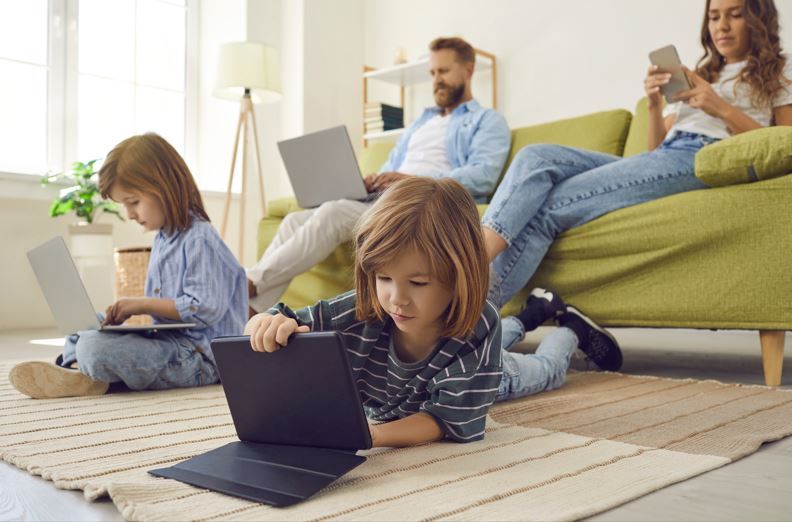- Clinical Technology
- Adult Immunization
- Hepatology
- Pediatric Immunization
- Screening
- Psychiatry
- Allergy
- Women's Health
- Cardiology
- Pediatrics
- Dermatology
- Endocrinology
- Pain Management
- Gastroenterology
- Infectious Disease
- Obesity Medicine
- Rheumatology
- Nephrology
- Neurology
- Pulmonology
Family-Wide Limit on Screen Media Use Improves Youth Mental Health: RCT Findings
Limiting screen media use to 30 minutes per day or less for all family members improved mental health measures among youth aged 4 to 17 years in this randomized trial.
Reducing family-wide use of leisure-time screen media for 2 weeks resulted in significant improvement on mental health measures in children and adolescents that included reduced scores for internalizing symptoms (emotional symptoms and peer problems) and increased scores for prosocial behavior.
The findings, published in JAMA Network Open, come from a recent secondary analysis of the SCREENS (Short-Term Efficacy of Reducing Screen-Based Media Use) trial.
©Studio Romantic/stock.adobe.com

The original SCREENS trial found that children and adolescents randomly assigned to screen media reduction increased their nonsedentary leisure time by 45 minutes per day compared with children and teens in the control group.
In the current analysis, Jesper Schmidt-Persson, PhD, assistant professor in the department of sports science and clinical biomechanics at the University of Southern Denmark, in Odense, and colleagues, report results for the impact of reduced screen media use on children’s and adolescent’s behavioral strengths and difficulties based on performance on the Strengths and Difficulties Questionnaire (SDQ).
Based on data from the SDQ administered after 2 weeks of restricted screen media use by parents, children, and adolescents in participant households, the researchers reported a statistically significant between-group mean difference in change on the total difficulties score among the youths from baseline of −1.67 (95% CI, −2.68 to −0.67) that favored the reduction intervention (Cohen d effect size, 0.53). Results of the sensitivity analysis for the total difficulties score were similar, with a between group mean difference of−1.71 (95% CI, −3.10 to −0.33), according to the study.
When they analyzed subscales of the SDQ (ie, internalizing and externalizing symptoms) Schmidt-Persson et al found the effect was more pronounced on the internalizing type, ie, emotional problems and peer problems, at −1.03; 95% CI, −1.76 to −0.29. They also reported a significant intervention effect reflected in the SDQ score for the prosocial subscale for the screen media reduction group (0.84; 95% CI, 0.39-1.30). When they removed the adjustment for age in all analyses, the results were not changed.
Screen Media Menace
Although screen media devices, particularly smart phones, have the potential for enhancing daily activities and some social interactions, the potential negative effects on mental health, especially the emotional health of children and adolescents, has become clear, the authors wrote. Investigators cite research illustrating the vulnerability of this young population that shows “self-reported life satisfaction has the steepest decrease during adolescence compared with other stages of the lifespan.” Yet despite growing alarm and indeed threats of federal intervention in the US to protect the mental health of minors engaged in extensive screen use, the authors note that research on the topic remains “sparse and inconclusive,” and is largely composed of observational studies and systematic reviews and meta-analyses.
To begin building a foundation of evidence, Schmidt-Persson and team conducted what they believe is the “first family-based randomized clinical trial” that specifically examines the effect of reducing leisure-time screen media use and the emotional health of youth.
The analysis included 89 families, with 181 children and adolescents recruited between June 6, 2019, and March 30, 2021, from municipalities in southern Denmark. Requirements for participation were parental screen use time above the 40th percentile (based on 1000 families) and either full-time employment or full-time student status. Families with children younger than age 4 were not eligible.
In the screen media reduction group were 45 families (86 children) with a mean age of 8.6 (range, 4 to 17) years and an approximately even split between girls and boys. The control group families numbered 44 and included 95 children whose mean age was 9.5 (range 4 to 15) years with more girls (60%) than boys. The median number of household screen devices in the intervention group was 9 and in the control group 11. Schmidt-Persson and colleagues reported similar baseline characteristics across the groups.
The families were randomly assigned to the screen media reduction or control groups. Participants in the reduction group were allocated 3 hours per week or less per person for the 2-week intervention period and were required to surrender smart phones and tablets (a "non-smart" phone was provided for phone calls). They were asked additionally to reduce time spent on all other screen media other than required for self-reported work or school hours.
Participants were allowed 30 minutes per day of “necessary” screen media use for tasks including appointment-making and school assignments. Control group families were asked to continue their normal behavior until follow up measurements were completed.
The authors acknowledge they can only speculate on the “mechanisms underlying the positive effect of limiting screen media use” on this young population’s mental health. They point to several possibilities, one being that self-reported mental well-being improved among parents participating in the SCREENS trial and another that potential salutary effect of increased shared leisure time with family in the absence of screens.
“Future research should explore the potential differential effects of various types of screen media use and look deeper into whether collective family participation in such interventions is a pivotal component for observed benefits,” authors wrote in conclusion. “Moreover, more research is needed to confirm whether these effects are sustainable in the long term.”
Source
Schmidt-Persson j, Rasmussen MGB, Sørensen SO, et al. Screen media use and mental health of children and adolescents: a secondary analysis of a randomized clinical trial. JAMA Netw Open. 2024;7(7):e2419881. doi:10.1001/jamanetworkopen.2024.19881
